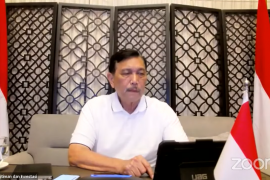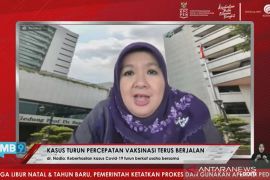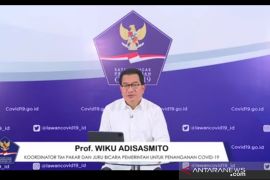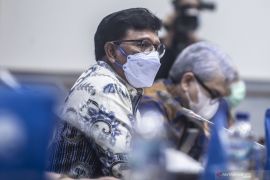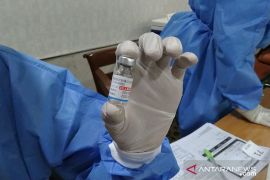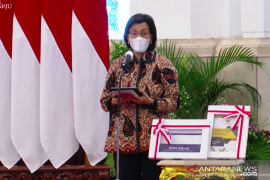The country recorded 168 daily cases on May 2, 2022, and 218 cases on May 30, fueling hopes of a shift to endemicity. However, the number of daily cases shot up to 1,242 on June 15.
President Joko Widodo has urged officials to improve the accessibility of the COVID-19 booster vaccine to prevent a spike triggered by the new subvariants, BA.4 and BA.5.
So far, the government has administered the first and second doses of the COVID-19 vaccine to a total of 168,183,942 people, or 80.75 percent of the national target of 208,265,720 people.
On June 10, the Health Ministry informed that the recent uptick in COVID-19 cases in Indonesia has been triggered by the Omicron BA.4 and BA.5 subvariants, which entered the country in early June 2022.
The BA.4 and BA.5 subvariants can evade immunity formed through vaccination and spread rapidly. The current increase has nothing to do with the easing of restrictions during the holidays and has been caused by the spread of new variants.
As of June 15, at least 20 cases of the BA.4 and BA.5 subvariants have been detected in Indonesia.
Health Minister Budi Gunadi Sadikin assured that the situation in Indonesia is still under control based on the two World Health Organization (WHO) indicators.
The two indicators are the positivity rate or the proportion of positive people out of all those tested.
In Indonesia, the positivity rate is below 5 percent. Nationally, it is now pegged at 1.15 percent, with the highest rate recorded in Jakarta at 3 percent.
Therefore, the Ministry of Health is striving to prevent an increase in the number of cases in Jakarta by intensifying case tracking and the enforcement of health protocols.
The second indicator is community transmission or the transmission of SARS-CoV-2 in the community.
While the WHO threshold is 20 per 100 thousand population per week, Indonesia’s community transmission rate is pegged at around one per 100 thousand population.
Epidemiologically, the BA.4 variant has been identified in 61 countries, mostly in South Africa, the United States, the United Kingdom, Denmark, and Israel, from 7,524 sequences that have been reported through the Global Initiative on Sharing All Influenza Data (GISAID).
The BA.5 subvariant has been detected in 65 countries, including the United States, Portugal, Germany, the United Kingdom, and South Africa, through 10,442 sequences reported via GSAID.
The subvariants can transmit faster among people, but there has been no indication so far that they cause higher severity compared to the other subvariants of Omicron. The mortality rate of the new variants is also lower, only one-twelfth or one-tenth of that of Delta and Omicron.
Minister Sadikin estimated that BA.4 and BA.5 cases will peak to 25 thousand per day at the most in Indonesia, as reflected by the monitoring of the variants in other countries.
The peak of cases usually occurs one month after the first case is identified. In the present case, it is estimated that the peak of BA.4 and BA.5 cases in Indonesia is likely to occur in the third and fourth weeks of July 2022.
Previously, Indonesia has witnessed three COVID-19 surges, with daily cases reaching up to around 60 thousand.
The first wave was recorded from January to March 2021 and was triggered by the Alpha variant. The second wave from May to July 2021 was caused by the Delta variant. The third wave was witnessed in February–March 2022 and was caused by the Omicron variant.
In anticipation of the fourth wave, the Health Ministry has intensified whole-genome sequencing (WGS) to check the presence of BA.4 and BA.5 subvariants in 1,242 patients confirmed positive for COVID-19 nationally as of June 15.
The ministry is still collecting reports on WGS research results from five provinces experiencing an upward trend in cases, Health Ministry's Spokesperson Mohammad Syahril said at a dialogue entitled “Beware, Omicron is back in Indonesia.”
It has also issued a circular asking all health offices and hospitals to remain alert for a spike in BA.4 and BA.5 cases and prepare all resources to provide health services to the community.
Meanwhile, the COVID-19 Task Force has asked the relevant authorities to conduct epidemiological molecular surveillance by applying appropriate methods in order to determine specific causes for the increase in the number of cases in the country.
Spokesperson for the COVID-19 Task Force Prof. Wiku Adisasmito said that the reasons for the current spike in cases include increased mobility of the people, neglect of health protocols, and the emergence of the BA.4 and BA.5 Omicron subvariants.
Adisasmito then called for efforts to identify the specific cause for the increase in COVID-19 cases in Indonesia at least in the next two to three weeks so that the situation can be brought under control.
In the meantime, the Wisma Atlet Emergency Hospital for COVID-19 has ensured the availability of facilities and infrastructure to respond to any surge in COVID-19 cases, Major General Dr. Budiman, the emergency hospital coordinator, said.
The hospital has prepared human resources, medical equipment, medicines, oxygen, and personal protective equipment, as well as ensured the availability of 3,801 beds for patients, according to Budiman.
However, the most important thing is that the public remains vigilant and strictly applies proper health protocols to prevent the spread of the virus.
According to the COVID-19 Handling Task Force’s data, as of June 17, the nation has recorded a total of 6,064,424 COVID-19 cases, 5,901,083 recoveries, and 156,673 deaths.
Related news: Ministry seeks stricter implementation of health protocols in schools
Related news: Indonesia intensifies genome sequencing to trace BA.4, BA.5 cases
Editor: Rahmad Nasution
Copyright © ANTARA 2022

